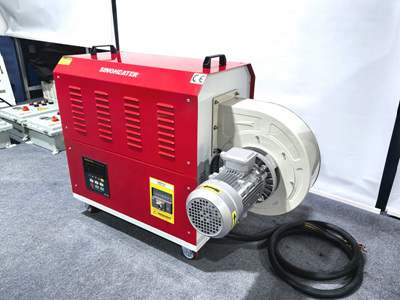In plastic welding, the air velocity adjustment of the hot air blower directly affects the welding quality. It is necessary to precisely control it in combination with the material properties, process requirements and equipment parameters. The following are the core points of wind speed adjustment and specific operation suggestions:
First, the core principle of wind speed regulation
Match the material properties
Thin-walled plastics (such as PP, PE) : Low wind speed (1-2 levels) is required to prevent excessive cooling or deformation of the plastic surface due to high wind speed.
Thick-walled plastics (such as ABS, PC) : Moderate wind speed (2-3 levels) is required to ensure uniform heat penetration into the weld seam and promote the fusion of molecular chains.
For special materials (such as PTFE, PVC) : The wind speed should be adjusted in combination with the material’s temperature resistance to prevent material decomposition or weld embrittlement due to improper wind speed.
Matching welding process
Hot air welding: The wind speed must be stable to ensure that the electrode and the base material soften simultaneously, avoiding false welding or overburning of the weld seam.
Hot plate welding: The wind speed is mainly used for auxiliary cooling. It should be switched to a low wind speed after the welding is completed to prevent the weld seam from shrinking and cracking.
High-frequency welding: The wind speed should be matched with the high-frequency vibration frequency to avoid poor contact of the welding surface caused by air flow interference.
Match the equipment parameters
The power of the hot air blower: For high-power equipment, the wind speed needs to be reduced to avoid excessive heat concentration. Low-power equipment needs to increase the wind speed to ensure the efficiency of heat transfer.
Air nozzle design: Narrow slit air nozzles need to reduce wind speed and concentrate heat. The wide-mouth air nozzle needs to increase the wind speed and expand the heating range.
Second, specific operational suggestions for wind speed adjustment
Adjust the wind speed in stages
Preheating stage: Low wind speed (1st level), slowly increase the surface temperature of the plastic to avoid heat loss due to excessive wind speed.
Welding stage: Adjust the wind speed according to the thickness of the material to ensure that the plastic at the weld seam is fully softened and does not sag.
Cooling stage: Low wind speed (level 1 wind gear) or natural cooling to prevent weld shrinkage and cracking caused by excessive wind speed.
Combined with temperature control
Thin-walled plastic: Wind speed of 1-2 levels, temperature of 200-250℃, ensure that the plastic surface softens rapidly without decomposition.
Thick-walled plastic: Wind speed 2-3 levels, temperature 250-300℃, ensure heat transfer to the interior of the weld seam.
Special materials: The optimal combination of wind speed and temperature needs to be determined through experiments. For example, when welding PTFE, the wind speed should be controlled below level 1 and the temperature should not exceed 327℃.
Dynamic adjustment of wind speed
Real-time monitoring of weld seam status: Adjust the wind speed by observing the color of the weld seam (from transparent to semi-transparent) or the feel (the degree of fusion between the electrode and the base material).
Avoid sudden changes in wind speed: Wind speed adjustment should be smooth to prevent fluctuations in weld quality caused by sudden changes in wind speed.
Third, precautions for wind speed adjustment
Safe operation
Avoid direct contact of the air nozzle with the human body or flammable materials to prevent scalding or fire.
When operating, wear protective glasses and gloves to prevent injury from hot air or splashing objects.
Equipment maintenance
Regularly clean the air nozzles and air ducts to prevent dust or foreign objects from blocking and affecting the stability of the wind speed.
Check the fan and heating elements to ensure the normal operation of the equipment.
Environmental adaptation
In low-temperature or high-humidity environments, the wind speed should be appropriately increased to compensate for heat loss.
When operating in a confined space, it is necessary to ensure good ventilation to prevent the accumulation of hot air from causing the equipment to overheat.
Fourth, Summary
The wind speed adjustment of the hot air blower in plastic welding needs to comprehensively consider the material properties, process requirements and equipment parameters. Through phased adjustment, combined with temperature control and dynamic adjustment, the quality of the weld seam can be ensured. When operating, pay attention to safety, equipment maintenance and environmental adaptation to avoid welding defects caused by improper wind speed. By accumulating experience through practice, one can gradually master the optimal wind speed adjustment techniques, thereby enhancing the efficiency and quality of welding.




